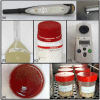Evaluation of the Demineralization Development around Different Types of Orthodontic Brackets
- PMID: 36769990
- PMCID: PMC9917947
- DOI: 10.3390/ma16030984
Evaluation of the Demineralization Development around Different Types of Orthodontic Brackets
Abstract
The aim of this study was to compare the demineralizations of the enamel surfaces around different types of orthodontic brackets in an artificial cariogenic environment. A total of 90 extracted human maxillary first premolar teeth were used in this in vitro study. The teeth were divided into 6 groups, 5 study and 1 control, each consisting of 15 samples. Victory metal, Gemini metal, Clarity self-ligating ceramic, APC Clarity Advanced ceramic and Clarity Advanced ceramic brackets (3M Unitek, Monrovia, Calif) used in the study groups were bonded to the teeth with the direct technique. The gingival, occlusal and proximal enamel surfaces adjacent to the brackets were measured with a DIAGNOdent pen (KaVo, Biberach, Germany) (T0). Then, the teeth were placed in a cariogenic suspension environment containing Streptococcus mutans, sucrose and artificial saliva. The teeth were removed from the cariogenic suspension at the end of 28 days. Enamel surfaces were remeasured with DIAGNOdent and the values were recorded (T1). Whether the obtained data were homogeneously distributed or not was determined by the Kolmogorov-Smirnov test, within-group comparisons were performed with the Wilcoxon test, and between-group comparisons were performed with Mann-Whitney U and Kruskal-Wallis tests. Significance level was accepted as p < 0.05. In all groups, the demineralization values of the enamel surfaces in the gingival, proximal and occlusal surfaces adjacent to the brackets were significantly higher in the T1 period than in the T0 period (p < 0.05). In the T1 period of Gemini metal, Clarity self-ligating ceramic and Clarity advanced ceramic bracket groups, the demineralization values of the proximal enamel surfaces were found to be significantly higher than the Victory metal and APC Clarity Advanced ceramic bracket groups (p < 0.05). In the T1 period, the demineralization values of the occlusal enamel surfaces of the Victory metal, APC Clarity Advanced ceramic bracket groups and control group were significantly lower than the Gemini metal, Clarity self-ligating ceramic and Clarity Advanced ceramic bracket groups (p < 0.05). Significant increases in enamel demineralization values were observed as a consequence of increased retention areas for microbial dental plaque on enamel surfaces adjacent to the bracket. Considering the importance of minimizing enamel demineralization in fixed orthodontic treatments, less enamel demineralization in Victory metal and APC Clarity Advanced ceramic bracket groups showed that these brackets can be preferred in patients with poor oral hygiene.
Keywords: DIAGNOdent; Streptococcus mutans; artificial saliva; bond; bracket; cariogenic environment; demineralization; dentistry; orthodontics.
Conflict of interest statement
The authors declare no potential conflicts of interest with respect to the authorship and/or publication of this article. The authors report no commercial, proprietary, or financial interest in the products or companies described in this article.
Figures


Similar articles
-
An in vitro evaluation of a metal reinforced orthodontic ceramic bracket.Am J Orthod Dentofacial Orthop. 1999 Dec;116(6):635-41. doi: 10.1016/s0889-5406(99)70198-8. Am J Orthod Dentofacial Orthop. 1999. PMID: 10587597
-
Comparison of Frictional Forces Generated by a New Ceramic Bracket with the Conventional Brackets using Unconventional and Conventional Ligation System and the Self-ligating Brackets: An In Vitro Study.J Int Oral Health. 2015 Sep;7(9):108-13. J Int Oral Health. 2015. PMID: 26435628 Free PMC article.
-
Enamel demineralization around two different orthodontic bracket adhesive systems: An in vivo study.Saudi Dent J. 2019 Jan;31(1):99-104. doi: 10.1016/j.sdentj.2018.11.005. Epub 2018 Nov 23. Saudi Dent J. 2019. PMID: 30723365 Free PMC article.
-
Managing oral biofilms to avoid enamel demineralization during fixed orthodontic treatment.Korean J Orthod. 2023 Nov 25;53(6):345-357. doi: 10.4041/kjod23.184. Epub 2023 Sep 15. Korean J Orthod. 2023. PMID: 37989574 Free PMC article. Review.
-
A Review on Orthodontic Brackets and Their Application in Clinical Orthodontics.Cureus. 2023 Oct 7;15(10):e46615. doi: 10.7759/cureus.46615. eCollection 2023 Oct. Cureus. 2023. PMID: 37937031 Free PMC article. Review.
Cited by
-
Vertical Dimension Control in Two Different Treatment Protocols: Invisalign First and Bite Block-A Retrospective Study.Children (Basel). 2024 Oct 17;11(10):1252. doi: 10.3390/children11101252. Children (Basel). 2024. PMID: 39457217 Free PMC article.
-
Murine Models in Oral Research: A Narrative Review of Experimental Approaches and Cardiovascular Implications.Biology (Basel). 2025 Jan 26;14(2):127. doi: 10.3390/biology14020127. Biology (Basel). 2025. PMID: 40001895 Free PMC article. Review.
-
Expression of artefacts from different orthodontic brackets and wires in cone beam computed tomography scans-an in vitro study.Clin Oral Investig. 2024 Jul 26;28(8):450. doi: 10.1007/s00784-024-05840-x. Clin Oral Investig. 2024. PMID: 39060664
-
Antimicrobial Effects of Edible Mixed Herbal Extracts on Oral Microorganisms: An In Vitro Study.Medicina (Kaunas). 2023 Oct 4;59(10):1771. doi: 10.3390/medicina59101771. Medicina (Kaunas). 2023. PMID: 37893489 Free PMC article.
-
Oral Health-Related Quality of Life After Allogeneic Bone Marrow Transplant-A Cross-Sectional Study.Healthcare (Basel). 2025 Mar 5;13(5):561. doi: 10.3390/healthcare13050561. Healthcare (Basel). 2025. PMID: 40077124 Free PMC article.
References
-
- Ülgen M. Ortodonti; Anomaliler, Sefalometri, Etioloji, Büyüme ve Gelişim, Tanı. 2nd ed. Yeditepe University Publication; Istanbul, Turkey: 2000. pp. 1–7.
-
- Proffit W.R., Fields H.W., Larson B., Sarver D.M. Contemporary Orthodontics. 6th ed. Elsevier Health Sciences; Philadelphia, PA, USA: 2018. pp. 321–332.
-
- Tosun Y. Sabit Ortodontik Apareylerin Biyomekanik Prensipleri. Ege University Publication; Izmir, Turkey: 1999. pp. 72–77.
LinkOut - more resources
Full Text Sources

